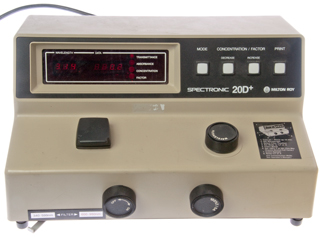Spectronic 20D Spectrophotometer
© Brooke Clarke 2014
This was designed as an educational tool and is used in a large number of both classical and organic chemistry and biology classes to determine the light transmission or absorption in liquids of light at different wavelengths (colors). This single beam spectrophotometer covers a wavelength range of 340 to 950 nm according to the manual, but as you can see in the photos the range is closer to 314 to 991 nm.
The first model in this series was the Spectronic 20 (Wiki) that used an analog meter. Introduced by B&L (Wiki) in 1953 and over 600,000 units have been made.
The "D" in the model number means Digital readout. All models use a filament lamp for visible and near IR (to about 1,000 nm) and the model 21D adds a deuterium light source to get down to about 200 nm UV. The later model 200 can make a transmission or absorption plot all by itself. The 20D, when connected to a COM serial port can output the two meter readings to a computer or printer, but the computer can not control the 20D.
Beer Lambert Law (Wiki) - absorption is proportional to the product of light path length and concentration of substance. So you can find out the concentration.
There are a vast number of applications, in many diverse fields.
Method of operation
The light that hits the sample is close to monochromatic which is a requirement since if a white light hit the sample it may, because of Fluorescence (Wiki), emit a number of different wavelengths which would complicate interpreting the results.
The sample is held in either a test tube (Wiki) or Cuvette (Wiki). Note that for wavelengths below 380 nm glass and plastic can not be used and some from of quartz sample holder is needed. The other problem is that the sample holder seems to sit on the lamp house door (see Fig 5 below). That means the length of the test tube is important so that you can get it out.
Fig 2 Optical Schematic
The cam is shaped so that the Model 20 wavelength dial has a linear calibration.
At this point I'm guessing that a linear pot is coupled to the wavelength dial and drives the wavelength readout.
A better way would be for some type of color sensor to sample the light to measure it's color.
The filter is needed because diffraction gratings (Wiki) have harmonic outputs so to keep the light monochromatic a filter rejects the unwanted harmonic.
Photos
Electro-Optical Gadgest
Flashlights
LEDs
Lights
MicroPhotography - includes microscopes
Optics
Optical Bench
Optical Spectrum Analyzers
Brooke's: PRC68, Alphanumeric Index of Web Pages, Contact, Products for Sale
Page created 21 June 2014